They have Saturdays in the Afternoon, and Sundays, with Christmas Holidays, Easter call’d little or Piganinny Christmas, and some other great Feasts allow’d them for the Culture of their own Plantations to feed themselves from potatoes, yams and plantains….
Their owners set aside for each a small Ground and allow them the Sundays to manure it: in it they generally plant Maiz, Guiney Corn, Plantanes, Yams, Cocoes, Potatoes, etc. This is the food that supports them….
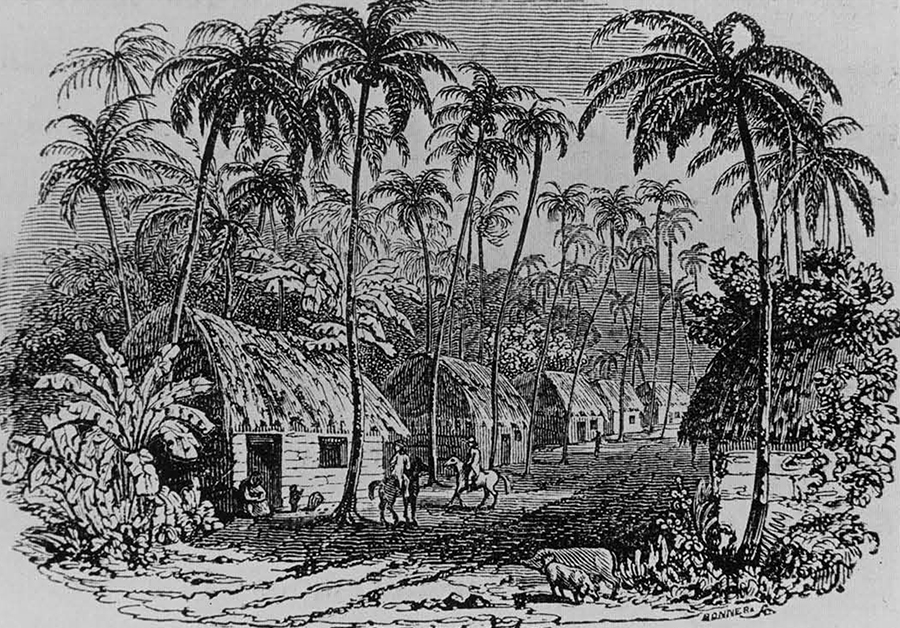
Prologue
Ink the tropical forest 2000 feet above the Caribbean Sea, Patrick Carty chops the french weed from the sweet potato and dasheen patch in his garden on the slopes of a high mountain basin known as Cadinge (Fig. 2). Halfway down these green southwestern slopes of the old “Sugar Island” of Montserrat, the grey stone ruins of the windmill tower at Galways plantation jut through the forest. A wash of rain sweeps briefly across the small clearing, then the sun re-emerges and the shadows it casts indicate to Carty that on this Thursday morning his six-hour stint of working his ground is drawing to a close.
Soon he and his friend Barzey will enjoy a mid-day meal of stew made with vegetables from the garden, and, for dessert, pineapple from Barzey’s “pine field.” Then he will load two crocus sacks of marketable produce-mostly sweet potatoes, christophenes, ginger, dasheen and Jimmyco beans-onto his donkey and set off down the mountain to his house in Morris village just above the sea.
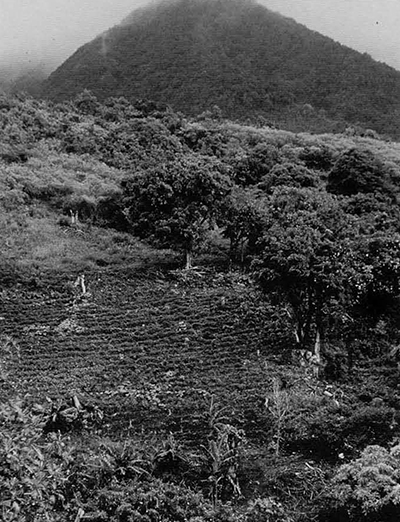
The two men have been cultivating at Cadinge for more than 50 years; they remember the excitement long ago when their mothers first let the 10-year-old boys come alone to the high forest to camp out for several days while tending the family mountain grounds. Now they set out together several times a week at three-thirty or four in the morning to climb Galways Mountain. Starting from the dry windswept slopes just above the sea, they pass through the grazing lands of lower Galways Mountain. At about 900 feet above the sea they enter a wetter zone.
Here tall trees can grow, while the intermittent well-drained sunny slopes of ravines are perfect for growing pineapples. Barzey’s field is one his uncle first got the right to cultivate when he was working in the nearby cotton fields in the 1930s.
Just above Churchyard Cate the men pass a tall dark stand of mango trees hung with philodendron and orchids. Black Mango is what people have called this place since their grandmothers’ time. Then, after passing the ruins of Gaiways, they wend their way through a damp ravine-Hollup Chaut-noted for its prolific breadfruit and Mamee Apple trees, and turn steeply up-slope past the overhanging “Nannyhouse-rock,” where their mothers often took shelter from the rain. At Cattle Spring they fill their water bottles, and after a steep climb they cross the Soufriere (a large active volcanic fumerole) at Buckra Dine (Fig. 3). They make the final ascent to the 2500-foot-high slopes of Cadinge, a location long valued for the cultivation of the sorts of plants that do best in consistently damp conditions: dasheen, christophenes, Hayti bananas, and ginger.
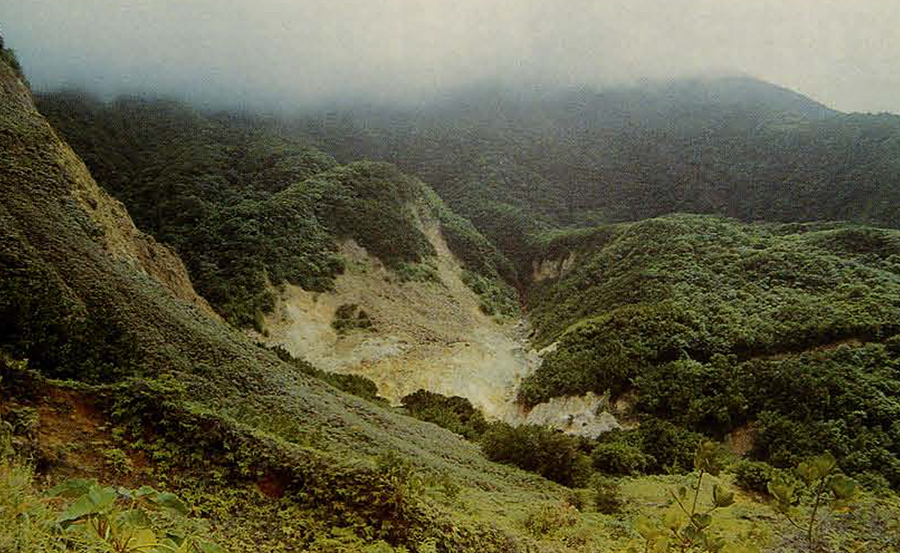
Although it is January 1986, Patrick Carty and Abraham Barzey are continuing in a way of life that is in many ways similar to that of their distant slave forebearers (Pulsipher 1989). Certainly they are freer to manage their own time, going to their mountain grounds at will. And they can choose to live on the land at the bottom of Galways Mountain near the main road, with piped water and electricity. Unlike the slaves, neither has to worry about securing the right to sell the produce of his labor; but both continue wary of the authorities because their mountain grounds are on Crown Lands that officially are not to be cleared of forest cover.
Like their great-great-grandparents, both men maintain plots around their houses and in several different mountain eco-zones; and they are intimately familiar with the requirements of the 40 or more species of plants they cultivate. Carty and Barzey put their garden produce to the same uses as their enslaved ancestors: they provide their families a balanced diet, they feed their pigs, goats, sheep, and chickens, and they sell the surplus produce and the animals in the market on Saturdays. The complex of plants they grow, with minor exceptions, is the very same one grown by slaves in the late 18th century.
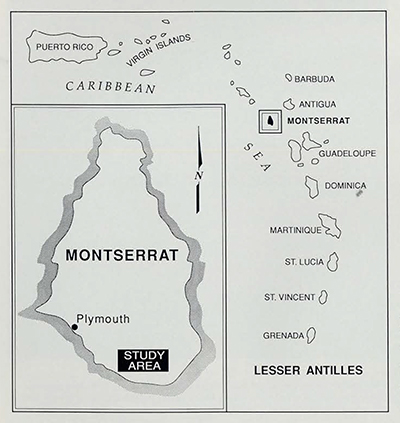
Galways Plantation
The ruins of Galways, once a sugar plantation, are located on the well-watered slopes of the Soufriere mountains on Montserrat Island in the eastern Caribbean (Figs. 4, 5). This plantation was home to hundreds of slaves during the 17th, 18th and early 19th centuries. Here they worked long hours in the cane fields and performed the countless tasks that were necessary to produce for Europeans the newly popular luxuries of sugar and rum.
In the few hours during the week that Caribbean slaves were spared from forced labor, they managed to create a way of life for themselves that included the cultivation of complex tropical gardens. On many islands these slave-managed gardens were so successful that they not only afforded slave families a nutritious diet, but also provided small sums of cash which were used to alleviate the harsh conditions of the plantation system. Slaves sold their excess produce and thereby enhanced the diets of others, both white and black.
Although life was hard and many died young from disease, the 10-year archaeological study of Galways indicates that the slaves there apparently did not suffer the nutritional stress that has been shown for slaves in Caribbean environments where gardening was restricted due to climatic conditions or to repressive plantation management (Corruccini et al. 1982, 1985). Not only do the human remains at Galways show that the slaves ate well enough to develop healthy bones and teeth free from signs of stress (Meadows 1989), but archaeological artifacts from the plantation village (Fig. 8) show that the slaves were able to provide themselves with material necessities and small luxuries such as tools, utensils, and dishes (Howson 1987). Quite likely these items were purchased by the slaves with cash earned through a variety of entrepreneurial activities, including tropical gardening.
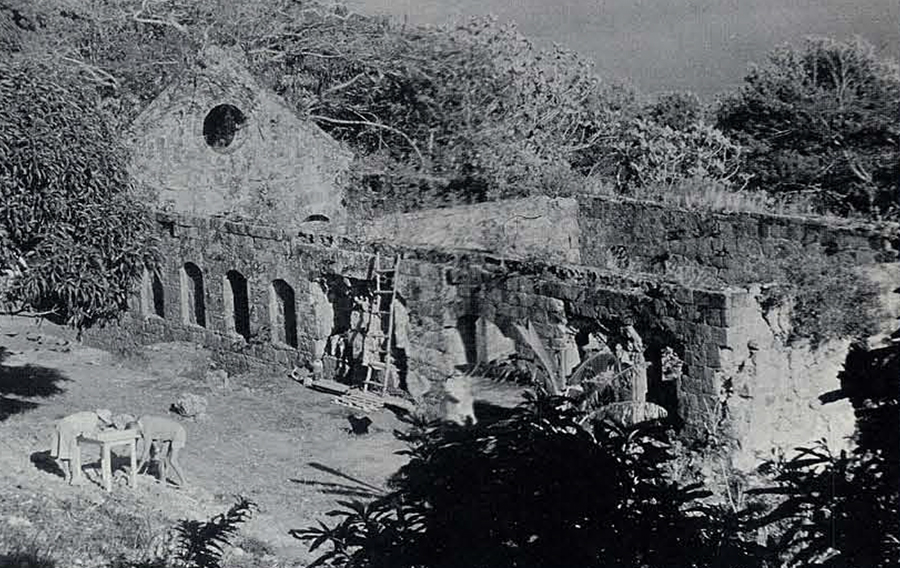
Four main sources have provided information about the location, scope, and character of the slave gardens associated with Galways plantation: (1) historical documents; (2) field analysis of human landscapes, including landforms and plant complexes; (3) oral tradition and folk geographies; and (4) the study of present-day traditional cultivation practices. Historical documents from the British Caribbean as a whole and the results of our study of Galways plantation on Montserrat indicate that there were at least three types of slave-grown gardens: common grounds, ravine and mountain grounds, and houseyard gardens. Each has had a distinctive impact on Caribbean landscapes. The first type was plantation-managed, while the second and third were established and managed by the slaves themselves, sometimes surreptitiously, but usually with the express or tacit consent of the plantation management.
Types of Slave Gardens
Common Grounds
In the 17th century planters were actually required by law to see that a certain number of acres of vegetable provisions were grown by and for the servants and slaves on each plantation.
…ally Masters of Families…residing on this Island, shall plant or cause to be planted One acre of Provision for every two working persons, Whites or Black, in their or any of their Families (that is to say) Potatoes or Cassad’ [cassava], or both…Laws of Montserrat, 15 1669; see also 36 1693
Maps of plantations (Fig. 9) throughout the British Caribbean confirm that such fields, often called provision grounds, were consistently a part of plantation layout (Higrnan 1988).
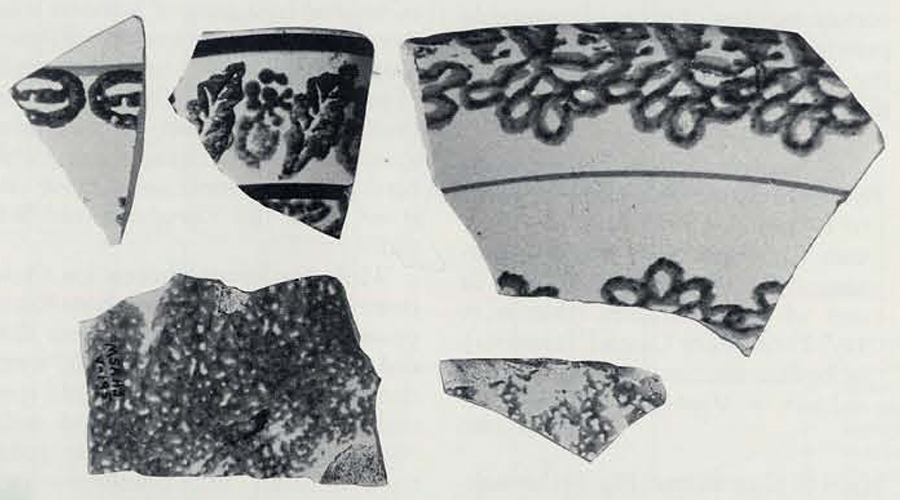
At least during the 17th century these plantation-managed plots were probably European in conception, location, shape, size and methods used. They were located on plantations proper, and hence tended to be on relatively flat land. According to European custom the plots were rectangular, were planted with a single or at most two crops, and were cultivated by a gang of laborers who gave little attention to micro-environments within a field or to the needs of individual plants. Therefore, even though the laborers in common grounds were African, the agricultural practices used were those derived from the European mid-latitudes.
While the crops chosen for these common grounds were not European, they tended to be those that did well in sunny open fields, were drought resistant, needed little special attention, and produced well. These crops—cassava, sweet potatoes, bananas, and plantains-provided a diet that was high in starch but lacking in essential nutrients. At Calways, though no maps survive, interviews with residents on the mountain have identified the locations and names of a number of such plantation provision grounds. Common grounds are no longer a part of Caribbean landscapes. They declined in importance as slaves took over the cultivation of their own food on mountain grounds and in houseyard gardens, and disappeared completely when the plantations died.
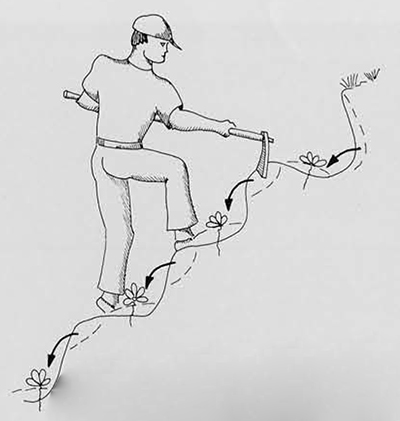
Ravine and Mountain Grounds
Slave-managed plots were grown surreptitiously perhaps as early as 1659, when laws were passed seeking to control the rambunctious behavior of slaves on Sundays. Later laws of the same type make it clear that the real point was not to keep the Sabbath, but rather to keep slaves from marketing surplus produce, partly because it was hard to tell if stave-sold produce was their own or stolen, but mostly because the entrepreneurial success of slave cultivators was putting white small-plot cultivators out of business. These whites were primarily freed Irish indentured servants who, it was hoped, would stay on Montserrat, thus bolstering the number of white settlers. Although, by law, slaves were forbidden to offer their produce for sale in the Sunday markets (Fig. 10) or in any other context, it is clear that the custom persisted: laws forbidding slaves to cultivate cash crops and to sell in Sunday markets were passed repeatedly well into the 18th century. The text of such laws often alluded to the impossibility of stamping out the practice (e.g., Laws of Montserrat 112 1736).
Just where such slave-managed plots would have been located during the early years of colonization is not clear. Modern cultivators, who are free to choose the place and time for their work, usually have several plots, some on the sunny, drier lower slopes of the mountains at about 1000 feet above the sea and some in the cooler, shaded, moist upland zones above 2000 feet. Slaves, however, had little free time and often needed to work covertly, so most of their plots were probably in nooks and crannies around plantation fringes where the choice of ecological niches was restricted. The plots were well out of sight of plantation managers, yet not too distant from slave villages. On mountainous islands such as Montserrat, they were almost inevitably on steep slopes, either on the banks of ravines or on high volcanic fingers too narrow or precipitous for sugar cultivation.
In 1988 the location of such a covert garden at Calways was pointed out to me by several descendants of the people who once cultivated there. In a dramatically deep water course called German’s Ghaut (ravine), which borders Gal-ways on the north, is a raised “island” consisting of 6 to 10 acres of gently sloping land surrounded by deep, heavily forested ravines. This formation, known as Little Island, was created when the mountain stream running in Cerman’s ravine divided and then rejoined further down slope. Today it is covered with a thick secondary forest of medium height, but that it was once cultivated is clearly indicated by the relict contour soil ridges created long ago to control erosion and enhance the environment for plants. While completely hidden from view, Little Island is no more than ten minutes from the Galways slave village.
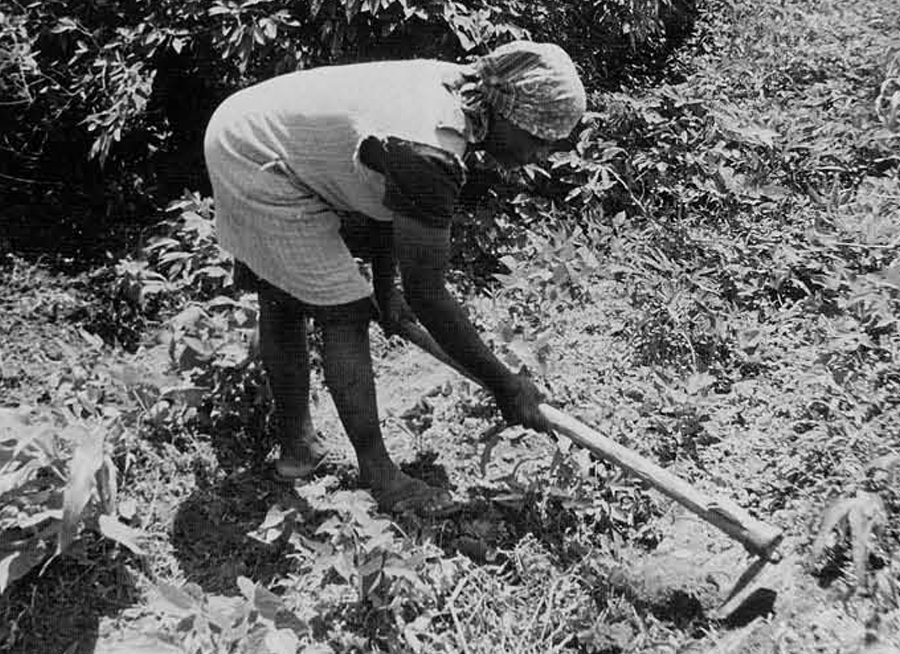
Later, in the 18th century, when planters allowed slaves Saturday afternoons and Sundays to cultivate, it was possible for slaves to have gardens in more remote upland zones. William Beckford, writing about Jamaica, observed: They generally make choice of such sorts of land for their ground as are encompassed by lofty mountains; and I think that they commonly prefer the sides of hills, which are covered with loose stones, to the bottoms upon which they are not so abundant. Some will have a mixture of both, and will cultivate the plantain-tree upon the flat and their provisions [root crops] upon the rising ground…. A Descriptive Account of the Island of Jamaica (London, 1790)
Historical descriptions from the wider Caribbean and archaeological evidence from Galways indicate that the tools and techniques used and the plants grown by slaves probably were very similar to those that survive in the mountain grounds of today. The gardens were an amalgamation of tropical plants brought from Africa (yams [IDioscorea], okra, dasbeen [Colocasia], pigeon peas, guinea corn), including several originally from Asia (banana, citrus, ginger), plants borrowed in the early years from surviving Carib and Arawak Indians (maize, peppers, pumpkins, christophenes [Chayote edulis, a green pear-shaped vegetable], sweet potato [Ipomea], cassava, beans, arrowroot [Maranta arundinacea L., the root which produces an easily digestable starch] pineapple, edible canna lily [Canna edulis]), and some European plants adapted to tropical conditions (cabbage, carrots, onions, thyme, rosemary, shallots). At the end of the 18th century, when plants were introduced to the Pacific, tree crops were enhanced with the addition of mangoes and breadfruit. The tools were surely very simple, at most a cutlass and a hoe (both probably of European origin but used by subsistence cultivators in Africa and American wet tropics, including forest fallowing, complex intercropping, and the banking of soil to inhibit erosion.
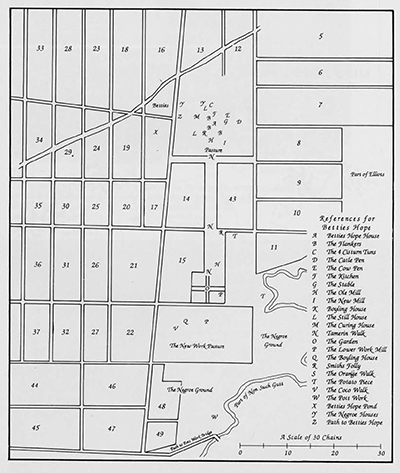
It is clear that both the historic and modern gardens represent a completely different concept of agriculture from the grounds described above. They are complex systems of environmental management that take into consideration angle of slope, moisture, availability, cycles of soil fertility, wind patterns, propitious times for planting, tending and harvesting, and the specific requirements of dozens of species grown. Plants are treated as individuals, with their micro-environments carefully managed for sustained or prolific production; and the continuous genetic selection of the most desirable characteristics in plants fosters improvement of the system over time (Fig. 8).
The fact that these slave plots were frequently on steep slopes, as most plots still are by choice today, necessitated erosion control strategies—chiefly the contour banking of soil. Geographer Carl Sauer suggests that this technique was first learned from the Indians in the early contact period (1954). My observations of cultivation practices today indicate that the soil banks present certain advantages beyond erosion in that they act as a sort of staircase from which workers can more easily reach rows upslope (Fig. 7). Furthermore, seedlings re planted in the furrows between banks where they are protected from excess sun and wind. As they mature, soil is pulled down around them from the ridge above, hence the ridge system actually moves downslope about a foot or so during the course of the growing season as the plants move to the top of a bank where they receive more intense sun. Tuber production is fostered by the loose soil, and moisture availability is controlled (Pulsipher 1978).
Interest in the story of how slaves came to be such great cultivators in the Caribbean was first generated by a landmark study published in 1960 by two anthropologists, Sidney Mintz and Douglas Hall. They established conclusively that by the beginning of the 18th century planters recognized the advantages of allowing slaves to cultivate their own food and sell the surplus: this practices relieved the planter from supplying sufficient food, and the slaves were apt to be more attached psychologically to a place as a result of their ability to tend gardens, keep animals and enjoy the little luxuries these entrepreneurial activities allowed. The authors document that the practice grew steadily, especially on hilly islands like Jamaica where plantations contained land unusable for kane cultivation. Custom allotted Saturday afternoons and Sundays for slaves to attend to their plots, and eventually entire islands became dependent upon slave-cultivated produced was sold in regular weekly markets (Mintz and Hall 1960). By the 19th century, attention was turning to the need to maintain slave populations through natural reproduction; as a result, Montserratian female slaves who had bourne five or more children were received from most fieldwork to tend their garden plots (slave Amelioration Papers 1823).
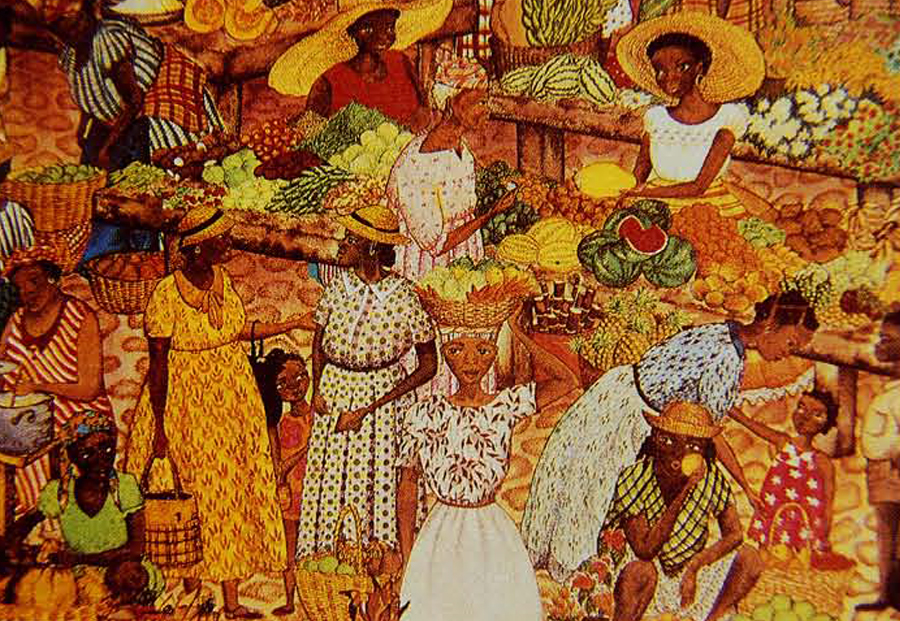
Slave Houseyard Gardens
The gardens that slaves planted around their houses are referred to in numerous descriptions: Adjoining to the house is usually a small spot of ground, laid out into a sort of garden and shaded by various fruit-trees…John Stewart, A view of the Past and Present State of the Island of Jamaica (Edinburgh; Oliver and Boyd, 1823), 267.
The cottages of the Negroes usually compose a small village… They are seldom placed with regard to order, but being always intermingled with fruit-trees, particularly the banana, the avocado, pear and the orange ( the Negroe’s own planting and property) they sometimes exhibit a pleasing and picturesque appearance…. Bryan Edwards, The History, Civil and Commercial, of the British West Indies (London: John Stockdale, 1793)
These gardens were also portrayed in a number of contemporary sketches and paintings (Figs. 1, 12). They differed from the ravine and mountain grounds in that they tended to be in somewhat drier zones, were smaller and stationary (as opposed to shifting), contained a less extensive and somewhat different complex of plants, and could be attended to and reaped from on a daily basis.
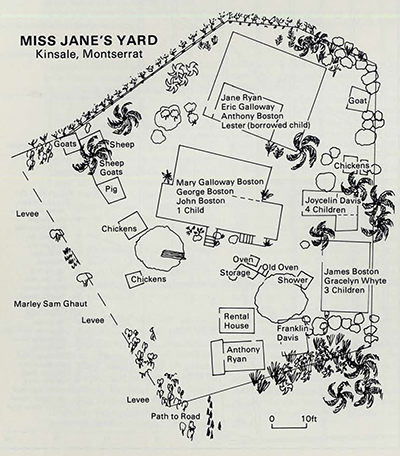
Slave villages were nearly always located near the central works of plantations; therefore, the ecological zones common for slave villages were coastal regions or relatively level upland flanks of mountains or interior valleys (Edwards 1793; Higman 1988). Because there were minimum moisture requirements for cane cultivation, houseyard gardens probably were rarely in truly dry zones; but on low dry islands such as Antigua and Barbados, slave cultivators would have had to cope with drought. Furthermore, cultivable land on such islands was at a premium, so all structures, including slave villages, occupied land not best suited for growing cane. Similarly on mountainous Montserrat, slave villages were not on the best land, although it was probably better than that allotted to their neighbors on Antigua.
The reduced complex of plants was due to the drier conditions and to the small garden spaces in slave villages. According to plantation maps and archaeological evidence, slave houses were normally only a few yards apart (Coodwin 1986). Illustrations and descriptions indicate that in all zones trees were an important component of houseyard gardens just as they are today (Kimber 1966), in part because tree Crops were especially susceptible to thievery and needed constant surveillance. Elderly Montserratians tell me that in the early 20th century, ownership of valuable trees like mango and breadfruit was the purview of the planter class, and laborers were punished for even picking fruit up off the ground. On the other hand, descriptions of gardens and of the slave-supplied market in Jamaica indicate that all types of fruit were grown by slaves (Long 1774, 2:105). Coconut palms were especially popular, probably because of their many uses (food, fiber, containers), and in dry, sunny coastal zones coconuts tended to be the dominant tree species. Bananas and plantains were also popular, in part for the cool ambiance they created.
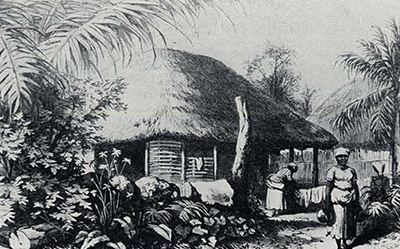
Depending on the amount of shade and moisture, other plants in house-yard gardens would have included herbs, leafy greens, roots and tubers, legumes, medicinals, cosmetics, ornamentals, and plants used in performing household chores or in making household items (Fig. 11). Examples of such plants would be the “pot-scrubber bush,” a rough-leaved member of the Compositae family used to clean dirty dishes; “colita” (Sansevieria), whose fibrous leaves were used to make ropes, collars, and lashes for small animals; “Cinty Bibey” (Aloe vera), used for burns and as an emetic; prickly pear cactus, used for hair conditioner and as “slime” to thicken certain dishes; tobacco; “chaney bush,” a large-leaved philodendron used as an umbrella and as packaging, and the tendrils of which were used as fiber; a wild legume used as an abortive; and lemon grass, used as a medicinal tea.
The tools and techniques used in houseyard gardens were the same as those used in mountain grounds, except that special care was given to maintaining fertility since only crop rotation, not plot rotation and fallowing, was possible. Slope management was less needed; but the moving soil-bank system described above was still used because of its other advantages for soil and micro-climate management.
Beyond Economics
Although slave gardens originated in early colonial days, and mountain grounds and houseyard gardens were important strategies employed by slaves to construct a decent life for themselves within a hostile system, these gardens remained important long after emancipation and, indeed, are still central in the subsistence economy of traditional West Indian people (Hills 1988). My conversations with present practitioners indicate that they were taught early by their elders that gardens had a significance beyond their economic function.
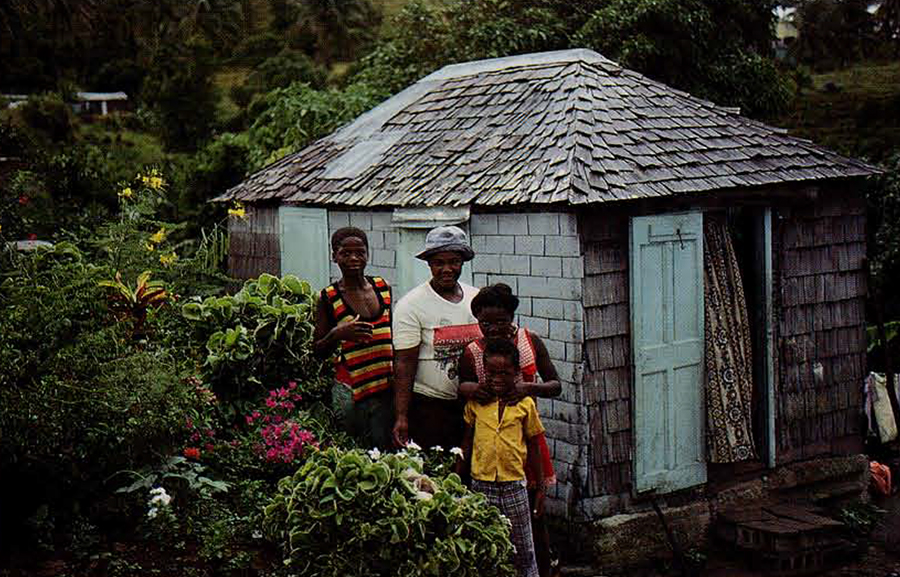
Cultivating on high remote slopes early in the morning calls up feelings of freedom and independence, of affinity with nature, of the solidarity of Black people in landscapes where whites rarely tread. The cultivators feel close to ancestors who worked the same spots, and their labors give them the sense of prosperity that abundant food symbolizes.
The folk names attached to particular plots and to places along the paths to the high fields convey these ideas as well (Fig. 14). “My Land Ghaut” carries obvious proprietary meaning; “Cabey Piece” recalls Jim Cabey who long ago worked that parcel; “Neger House” marks the remains of a slave village and calls up distant childhood memories of grandparents who cultivated there; “Buckra Dine” humorously identifies the place near the unpleasant sulphur-smelling volcano where white folks inexplicably choose to picnic; “Little Island” designates a secret cultivation plot near Calways; and “Cadinge” is the name for a cool remote region consistently supplied with moisture and a favorite for mountain grounds. “Big Rock” designates a good place to rest one’s load and chat with a friend, and “Power Piece” identifies a spot where in the 19th century missionaries established a school for the children of ex-slaves (Pulsipher 1987).
For slaves, houseyard gardens also symbolized independence, security, and pride of ownership just as they do in the present. Many writers noted the sense of pride with which slave proprietors took care of their plants and domestic animals.
“Behind the house is the garden filled with plantains, ochras, and other vegetables, which are produced at all seasons…. Every family has a hogsty: poultry houses are not wanted [as] the chickens are carefully gathered at night, and hung in baskets, to preserve them from the rats.” Alexander Barclay, A Practical View of the Present State of Slavery in the West Indies (London, 1826)
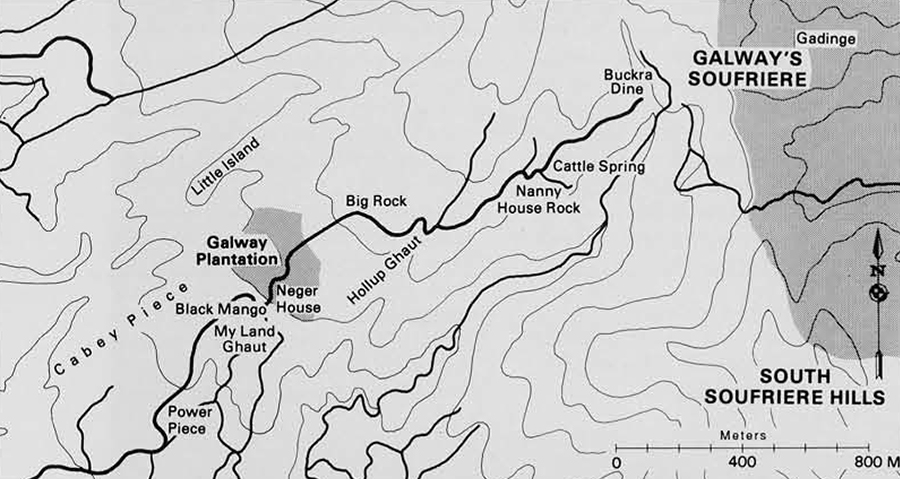
Today the obvious pride taken in a small house surrounded by flowers and garden plants is celebrated in the countless paintings and photos traded to tourists (Fig. 13); and many returned West Indian migrants have told me that fond memories of these small “estates” in the tropics sustained them through long years of toil in a European or North American city, as they supported families back home and saved for their retirement homecoming.
Although modernization, especially the importation of food from abroad, has greatly changed West Indian diets, the observant visitor to the islands can still see the remnants of this ancient and once widespread system of self-sufficiency: an elderly gentleman returning from the mountains on his donkey carrying a huge stem of bananas, a market woman smiling behind her table heaped with sweet potatoes, dasheen, and christophenes, or a tiny wooden house shaded by coconuts and surrounded by dozens of different edible, medicinal, and ornamental plants.
